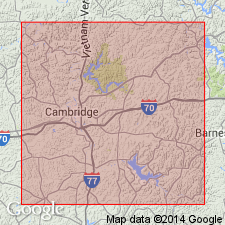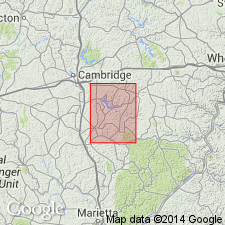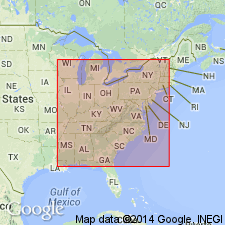
- Usage in publication:
-
- Cambridge limestone
- Modifications:
-
- Named
- Dominant lithology:
-
- Limestone
- AAPG geologic province:
-
- Appalachian basin
Summary:
Probably named for Cambridge, Guernsey Co., eastern OH. Thickness is 0 to 20 ft. Lies with Productive Coal Measures, about 225 ft below Pomeroy coal. Separated from higher Ames limestone by 85 to 90 ft of sandstone and shale.
Source: GNU records (USGS DDS-6; Reston GNULEX).

- Usage in publication:
-
- Cambridge limestone*
- Modifications:
-
- Revised
- Areal extent
- AAPG geologic province:
-
- Appalachian basin
Summary:
Revised as Upper Cambridge limestone and Lower Cambridge limestone, replacing Pine Creek and Brush Creek limestones. Extended to MD and WV(?). Age is Pennsylvanian.
Source: GNU records (USGS DDS-6; Reston GNULEX).

- Usage in publication:
-
- Cambridge limestone member*
- Modifications:
-
- Revised
- AAPG geologic province:
-
- Appalachian basin
Summary:
Rank reduced to Cambridge limestone member of Conemaugh formation. It crops out along valleys in vicinity of Senecaville and Lore City and is located about 155 ft above Upper Freeport coal. Is distinguished from other limestones by its dark-gray, smooth-textured, fossiliferous characteristics. Appears as both continuous layers and as nodules in clay. [Note that in text, is called Cambridge limestone, but in generalized sections, it is clearly labeled as Cambridge limestone member. GNC records show that Cambridge limestone member replaces what was previously called Upper Cambridge limestone; the name Brush Creek limestone member of the Conemaugh replaces what was previously called Lower Cambridge limestone.]
Source: GNU records (USGS DDS-6; Reston GNULEX).

- Usage in publication:
-
- Cambridge limestone
- Modifications:
-
- Areal extent
- Overview
- AAPG geologic province:
-
- Appalachian basin
Summary:
Cambridge limestone is an informal unranked widespread marine limestone exposed at Cambridge, Guernsey Co., OH. It occurs in the lower part of Conemaugh Formation between Portersville limestone (above) and Brush Creek Limestone Member in OH, PA, and MD. It is equivalent to Pince Creek limestone of PA and WV according to Wanless (1939).
Source: GNU records (USGS DDS-6; Reston GNULEX).
For more information, please contact Nancy Stamm, Geologic Names Committee Secretary.
Asterisk (*) indicates published by U.S. Geological Survey authors.
"No current usage" (†) implies that a name has been abandoned or has fallen into disuse. Former usage and, if known, replacement name given in parentheses ( ).
Slash (/) indicates name conflicts with nomenclatural guidelines (CSN, 1933; ACSN, 1961, 1970; NACSN, 1983, 2005, 2021). May be explained within brackets ([ ]).

